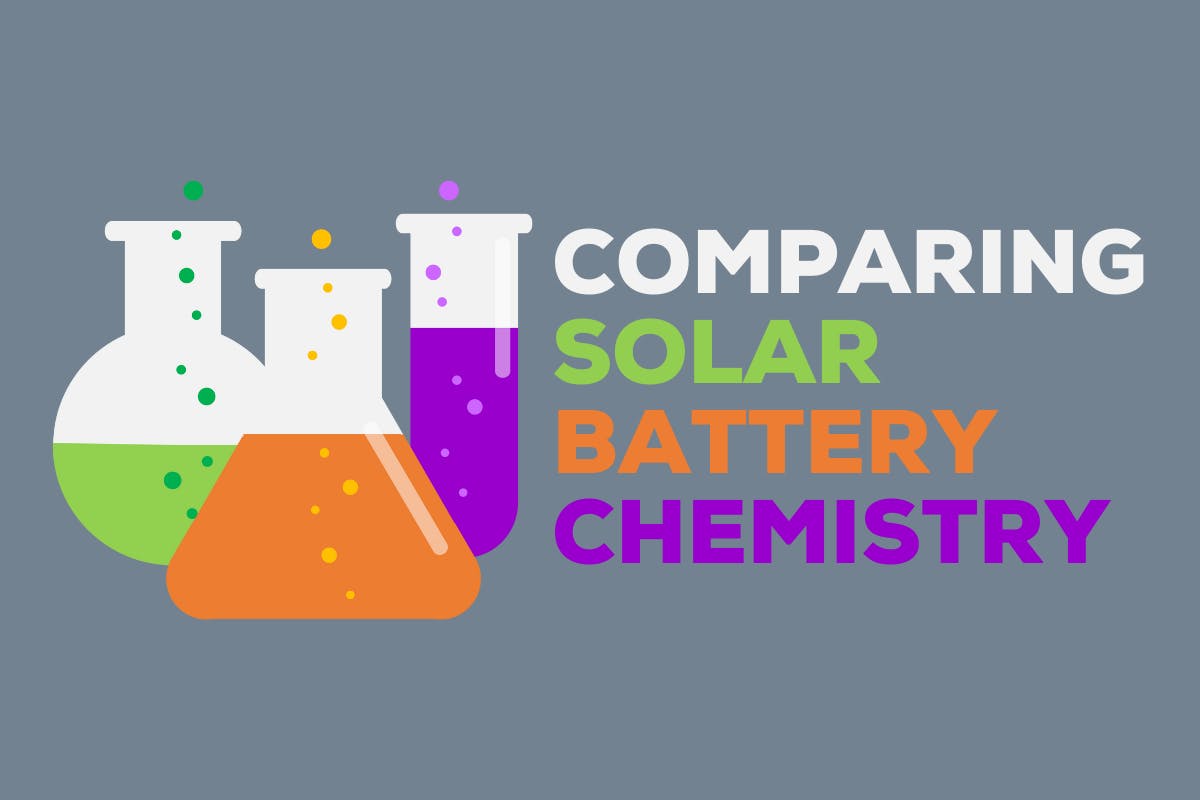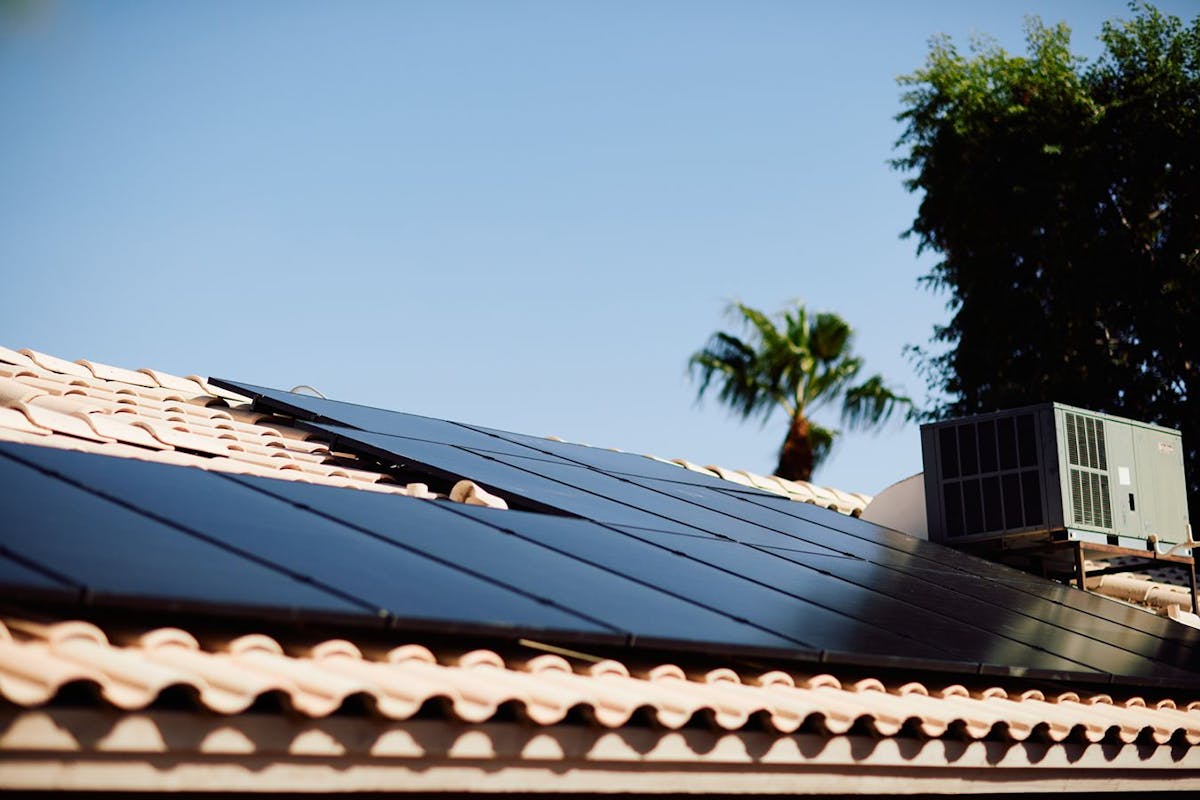Solar Battery Chemistry: Comparing Types of Solar Batteries
Last edited

Author
Andrew Blok
Electrification and Solar Writer and Editor

Editor
Andrew Giermak
Solar and Electrification Writer and Editor

Solar batteries are a vital part of more and more home solar panel systems. In some cases they can be a key way of gaining access to greater savings or backup power.
But not all batteries are created equal. From different sizes and capabilities to the very chemicals that store and discharge energy. While different battery chemistries have been around as long as there have been batteries and new ones are always emerging, one type of battery is dominant in home installations today. Here’s what you need to know about what makes batteries different and which type of battery is best for your home.
See how much you can save by going solar with Palmetto
What Is Battery Chemistry?
Battery chemistry is the mixture of chemicals that allows for a reaction within the cells of a battery, enabling electrical energy to become chemical energy, and chemical energy to become electrical energy. Different battery types are based on the different compositions of chemicals inside the cells, which determines their power level and backup power storage capacity when they store electricity.
What Types of Batteries Are Used for Solar Energy Storage?
Rechargeable batteries can be discharged and recharged for their expected lifespan before the chemical reaction becomes inert due to use. The batteries used in a solar battery bank are an industry-specific subset of these batteries that are designed for extra-long life and regular use.
Solar batteries for energy systems are large enough to accept the voltage from solar panels and store enough energy in order to discharge the appropriate amount of power your home needs. Thus, a battery chemistry comparison typically comes down to analyzing the tradeoffs between capacity and longevity.
The biggest difference between a traditional single-use battery and a rechargeable battery is the latter’s ability to absorb incoming energy and store it inside cells, without causing the chemical composition of the cells to deteriorate. Rechargeable batteries are made up of chemicals that can reverse their charge in order to retain energy, rather than deteriorate over time.
Attempting to charge a battery that wasn’t designed to have a charge reintroduced into the cells, such as in-home disposables (AA, AAA, C, D, 9V, etc.) can result in overheating and damage, due to the reactions in the cells.
Five main types of solar batteries are used for power storage.
- Lithium-ion
- Lead-acid
- Lithium-iron-phosphate (LFP)
- Nickel-cadmium
- Flow
Other less popular options for solar power storage include nickel-metal hybrid and nickel-zinc, but they have a smaller capacity and less durability when compared to the other options.
Lithium-Ion Battery Chemistry
Lithium-ion batteries are one of the most affordable versions of rechargeable battery technology. This battery’s versatility and size adaptability make it a leader in the light rechargeable battery category, which is why you’ll find it in electric cars, mobile phones, and laptops.
These solar battery cells contain an intercalate lithium compound and electrolytes. The lithium ions move through the electrolytes to the positive terminal, where they discharge and reverse direction to charge the battery. The charge moves back and forth within the electrolyte solution to create a positive charge for discharging and a negative charge to draw in power for storage.
Lithium-ion battery pros
Lithium-ion batteries are far and away the most common type of battery for home energy storage. That’s because they have quite a few things going for them.
- High energy density (it holds more power than other rechargeables)
- Fewer maintenance requirements
- Higher efficiency
- Longer lifespan
- Higher energy-to-weight ratio
- Minimal charge loss while not in use
Lithium-ion battery cons
Lithium-Ion batteries do have a few notable problems:
- A small risk of overheating and fire
- Small potential of health and environmental risk
If the lithium component leaks or burns it can be toxic. Correct placement and installation of the battery can reduce these risks.
Lithium-Iron-Phosphate (LFP) Battery Chemistry
The LFP battery is a type of lithium-ion battery that uses lithium, iron, and phosphate instead of lithium and cobalt oxide. LFP batteries use a lithium, iron, and phosphate cathode and the graphitic carbon electrodes to create the chemical reaction necessary to charge and discharge. It is a low-cost and low toxicity alternative to the lithium-ion battery.
Lithium-iron-phosphate pros
LFP batteries provide:
- Lower cost
- Better aging and lifespan
- Higher peak power ratings
- Better thermal stability
- Easier to source needed materials
- Lower potential human and environmental impact
The thermal stability of the LFP battery chemistry has given it an advantage over its more common lithium-ion siblings.
Lithium-iron-phosphate cons
LFP batteries don’t beat other lithium-ion batteries in every way. Disadvantages include:
- Poor low-temperature performance
- Deep discharge issues
- Requires protection from elements and temperature
Like the lithium-ion battery, storing an LFP solar battery requires consistent temperature control with an adequate maintenance schedule to ensure peak performance.
Lead-Acid Battery Chemistry
Lead-acid batteries consist of cells with porous lead in a solution of sulfuric acid and water. The energy is created and discharged by transforming the lead into lead sulfate crystals, and then back into lead and sulfuric acid when a device is attached to the terminals.
Lead-acid battery pros
Lead-acid batteries have powered vehicles and equipment for decades. They are heavy, but they last for years with proper maintenance and charging, offering a low-cost alternative to more advanced storage options. Here is lead-acid batteries’ main advantage.
- Lead-acid batteries are significantly cheaper than other more advanced battery chemistries.
Lead-acid battery cons
Because the lead-acid battery is one of the most common batteries used in automobiles, we know many of its disadvantages.
- Electrolyte and water loss due to the gassing process
- Movement can damage the electrodes attached to the soft lead terminals
- Sulfur spillage harms the environment, humans, and animals
- Reduced charge ability in freezing temperatures
You can keep lead-acid batteries healthy by storing them in an appropriate location and paying attention to corrosion, temperature, and water levels.
See how much you can save by going solar with Palmetto
Nickel-Cadmium Battery Chemistry
Nickel-cadmium batteries are high-powered and energy-efficient. They are mainly used for industrial, transportation, and aviation applications. These batteries are composed of nickel and cadmium in an alkali solution.
Nickel-cadmium battery pros
The nickel-cadmium battery has several advantages, including:
- Lower self-discharge rate (the rate at which the chemicals within the cells reduce their ability to store energy)
- High recyclability
- Broad temperature storage range
- Long cycle life
- Low maintenance requirements
Nickel-cadmium batteries resemble alkaline batteries (like AA and AAA) in shape because of the way the positive and negative poles are rolled to physically separate the terminals. Vented nickel-cadmium batteries have a long life (up to 20 years or more, depending on the type) and can function in temperatures ranging from −4 °F to 113 °F (−20 °C to 45 °C).
Nickel-cadmium battery cons
The main drawback of the nickel-cadmium battery is the actual cadmium contained within the cells. Cadmium is a toxic, heavy metal that has to be handled by individuals trained in hazardous waste removal. Due to health concerns, the European Union has banned its use in portable devices except in medical equipment. Other drawbacks include:
- Nitrogen impurities can cause increased self-discharge occurrence
- High electrolytic resistance (overcome with better technology)
- High cost
Nickel-cadmium batteries have to be stored away from wet areas, and the terminals must be kept clean. However, sealing the terminals to keep them clean can result in higher self-discharge and memory loss within the cells.
Additionally, overcharging can result in the loss of water in the form of gas, which reduces the amount of charge the cells can hold. The use of cheap charging devices can rapidly damage the cells because of overcharging and cause a significant decrease in longevity.
Flow Battery Chemistry
A flow battery has a unique composition compared to other batteries. It consists of two tanks of chemicals, such as a liquid bromine solution and hydrogen, that are pumped past a membrane held between two electrodes. The ion exchange through the membranes creates the charge that powers the cells.
Such a battery requires enough room for the tanks holding the chemicals, the pipelines they use, and the electrical components that pump the liquids through the membranes and to the terminals.
Flow battery pros
The unique battery type has several advantages.
- Nearly limitless lifespan
- More flexible layout
- No flammable liquids
- Well-suited for large-scale storage
Large facilities with plenty of space can benefit from these batteries because they can install a larger tank to store more electrolytes. The size of the tanks increases available storage, and the increased space between the various components reduces the electrolytes’ interaction, thus increasing lifespan.
Flow battery cons
Flow batteries have some significant disadvantages for home use.
- Low energy density (larger tanks are needed for useful charges)
- High costs
- Large space required for the separate chemical tanks
- Higher maintenance needs
Which Type of Solar Battery Is Right for You?
After weighing the pros and cons of the five battery types discussed above, most would agree that some type of lithium-ion battery is the best choice for storing solar energy. It remains the industry standard for solar battery storage due to its high capacity, long life, and space-saving design.
If you are concerned about your budget, then lithium-ion might be out of your price range, so lead-acid batteries are a budget-friendly alternative. However, while it can last for many years and has a low cost, it’s an older technology, so it may not work as well with a high-tech setup.
Battery Chemistry Matters When it Comes to Solar Storage
Adding battery systems to your residential solar power setup is an additional step you can take to reduce your reliance on the electricity grid, and solar panels and batteries can work together to provide the solar power your home needs.
Choosing the correct solar battery can mean increased savings and reliability. Selecting the best battery storage solution for your needs often comes down to the battery's composition and chemistry. It’s important to understand the fundamentals of each of the five major types of solar batteries, including their advantages and disadvantages.
When it’s time to install your solar panel system, consult with the solar experts at Palmetto. We have the experience and know-how to help you navigate the options and select the right solution to meet your long-term energy needs. We even offer our Palmetto Protect service, so you can get the ongoing support and maintenance you deserve.
To learn how much you could lower your home’s energy bills by switching to solar energy, get started today with our free solar savings calculator..
See what solar can do for you:
Frequently Asked Questions
What is the most common type of solar battery?
Lithium-ion batteries, including specific technologies like lithium-iron-phosphate batteries, are the most common type of home battery. They often provide the most storage for the least amount of money and have long lifespans and low maintenance needs.
Can I pick the type of battery I get installed at home?
Yes. Certain installers may only install certain types or brands of batteries. If you’re committed to working with a specific installer, you may have to pick from the options they install. If you’re committed to a specific battery, you’ll have to pick an installer that works with those batteries.
What battery chemistry does Tesla Powerwall use?
Tesla’s newest battery, the Powerwall 3, uses lithium-iron-phosphate chemistry. Earlier models, like the Powerwall 2, used a different lithium-ion chemistry, lithium nickel manganese cobalt oxide.


